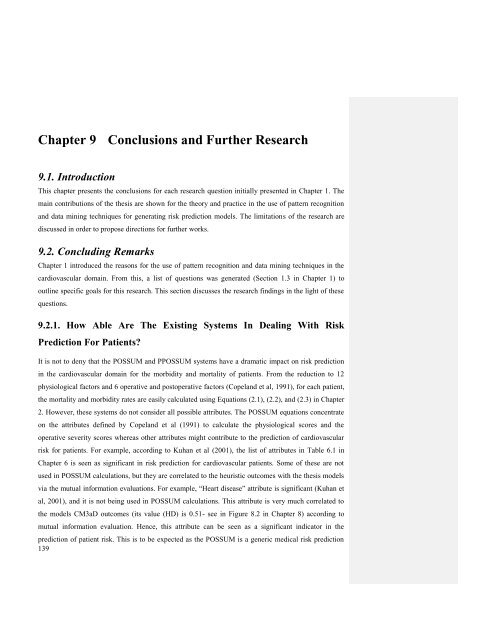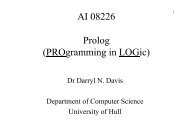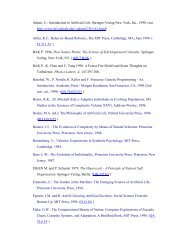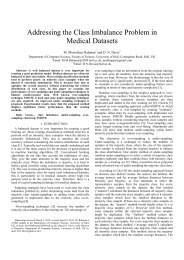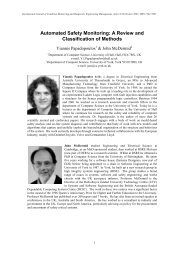Predicting Cardiovascular Risks using Pattern Recognition and Data ...
Predicting Cardiovascular Risks using Pattern Recognition and Data ...
Predicting Cardiovascular Risks using Pattern Recognition and Data ...
You also want an ePaper? Increase the reach of your titles
YUMPU automatically turns print PDFs into web optimized ePapers that Google loves.
Chapter 9 Conclusions <strong>and</strong> Further Research9.1. IntroductionThis chapter presents the conclusions for each research question initially presented in Chapter 1. Themain contributions of the thesis are shown for the theory <strong>and</strong> practice in the use of pattern recognition<strong>and</strong> data mining techniques for generating risk prediction models. The limitations of the research arediscussed in order to propose directions for further works.9.2. Concluding RemarksChapter 1 introduced the reasons for the use of pattern recognition <strong>and</strong> data mining techniques in thecardiovascular domain. From this, a list of questions was generated (Section 1.3 in Chapter 1) tooutline specific goals for this research. This section discusses the research findings in the light of thesequestions.9.2.1. How Able Are The Existing Systems In Dealing With RiskPrediction For Patients?It is not to deny that the POSSUM <strong>and</strong> PPOSSUM systems have a dramatic impact on risk predictionin the cardiovascular domain for the morbidity <strong>and</strong> mortality of patients. From the reduction to 12physiological factors <strong>and</strong> 6 operative <strong>and</strong> postoperative factors (Copel<strong>and</strong> et al, 1991), for each patient,the mortality <strong>and</strong> morbidity rates are easily calculated <strong>using</strong> Equations (2.1), (2.2), <strong>and</strong> (2.3) in Chapter2. However, these systems do not consider all possible attributes. The POSSUM equations concentrateon the attributes defined by Copel<strong>and</strong> et al (1991) to calculate the physiological scores <strong>and</strong> theoperative severity scores whereas other attributes might contribute to the prediction of cardiovascularrisk for patients. For example, according to Kuhan et al (2001), the list of attributes in Table 6.1 inChapter 6 is seen as significant in risk prediction for cardiovascular patients. Some of these are notused in POSSUM calculations, but they are correlated to the heuristic outcomes with the thesis modelsvia the mutual information evaluations. For example, “Heart disease” attribute is significant (Kuhan etal, 2001), <strong>and</strong> it is not being used in POSSUM calculations. This attribute is very much correlated tothe models CM3aD outcomes (its value (HD) is 0.51- see in Figure 8.2 in Chapter 8) according tomutual information evaluation. Hence, this attribute can be seen as a significant indicator in theprediction of patient risk. This is to be expected as the POSSUM is a generic medical risk prediction139


